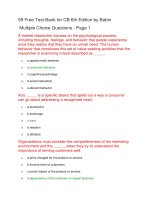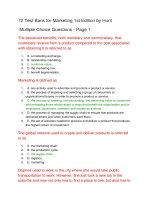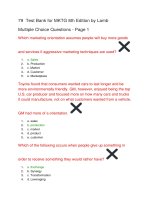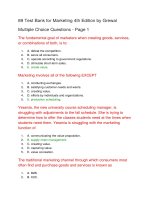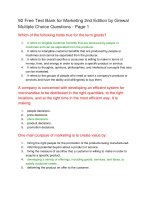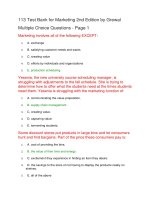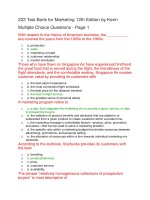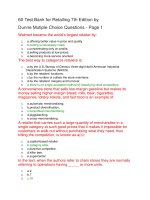Test bank for quantitative methods for business 11th edition by anderson
Bạn đang xem bản rút gọn của tài liệu. Xem và tải ngay bản đầy đủ của tài liệu tại đây (105.2 KB, 10 trang )
buy this full document at
1
Introduction
MULTIPLE CHOICE
1.
The field of management science
a.
concentrates on the use of quantitative methods to assist in decision making.
b.
approaches decision making rationally, with techniques based on the scientific method.
c.
is another name for decision science and for operations research.
d.
each of the above is true.
ANSWER:
d
TOPIC:
Introduction
2.
Identification and definition of a problem
a.
cannot be done until alternatives are proposed.
b.
is the first step of decision making.
c.
is the final step of problem solving.
d.
requires consideration of multiple criteria.
ANSWER:
b
TOPIC:
Problem solving and decision making
3.
Decision alternatives
a.
should be identified before decision criteria are established.
b.
are limited to quantitative solutions
c.
are evaluated as a part of the problem definition stage.
d.
are best generated by brain-storming.
ANSWER:
a
TOPIC:
Problem solving and decision making
Decision criteria
a.
are the choices faced by the decision maker.
b.
are the problems faced by the decision maker.
c.
are the ways to evaluate the choices faced by the decision maker.
d.
must be unique for a problem.
ANSWER:
c
TOPIC:
Problem solving and decision making
4.
5.
In a multicriteria decision problem
a.
it is impossible to select a single decision alternative.
b.
the decision maker must evaluate each alternative with respect to each criterion.
c.
successive decisions must be made over time.
d.
each of the above is true.
ANSWER:
b
TOPIC:
Problem solving and decision making
6.
The quantitative analysis approach requires
a.
the manager’s prior experience with a similar problem.
b.
a relatively uncomplicated problem.
buy this full document at
2
Chapter 1 Introduction
c.
d.
ANSWER:
TOPIC:
mathematical expressions for the relationships.
each of the above is true.
c
Quantitative analysis and decision making
7.
A physical model that does not have the same physical appearance as the object being modeled is
a.
an analog model.
b.
an iconic model.
c.
a mathematical model.
d.
a qualitative model.
ANSWER:
a
TOPIC:
Model development
8.
Inputs to a quantitative model
a.
are a trivial part of the problem solving process.
b.
are uncertain for a stochastic model.
c.
are uncontrollable for the decision variables.
d.
must all be deterministic if the problem is to have a solution.
ANSWER:
b
TOPIC:
Model development
9.
When the value of the output cannot be determined even if the value of the controllable input is known,
the model is
a.
analog.
b.
digital.
c.
stochastic.
d.
deterministic.
ANSWER:
c
TOPIC:
Model development
10.
The volume that results in total revenue being equal to total cost is the
a.
break-even point.
b.
marginal volume.
c.
marginal cost.
d.
profit mix.
ANSWER:
a
TOPIC:
Break-even analysis
11.
Management science and operations research both involve
a.
qualitative managerial skills.
b.
quantitative approaches to decision making.
c.
operational management skills.
d.
scientific research as opposed to applications.
ANSWER:
b
TOPIC:
Introduction
12.
George Dantzig is important in the history of management science because he developed
a.
the scientific management revolution.
b.
World War II operations research teams.
c.
the simplex method for linear programming.
d.
powerful digital computers.
ANSWER:
c
TOPIC: Introduction
13.
The first step in problem solving is
a.
determination of the correct analytical solution procedure.
b.
definition of decision variables.
c.
the identification of a difference between the actual and desired state of affairs.
Full file at />
d.
ANSWER:
TOPIC:
implementation.
c
Problem solving and decision making
14.
Problem definition
a.
includes specific objectives and operating constraints.
b.
must occur prior to the quantitative analysis process.
c.
must involve the analyst and the user of the results.
d.
each of the above is true.
ANSWER:
d
TOPIC:
Quantitative analysis
15.
A model that uses a system of symbols to represent a problem is called
a.
mathematical.
b.
iconic.
c.
analog.
d.
constrained.
ANSWER:
a
TOPIC:
Model development
TRUE/FALSE
1.
The process of decision making is more limited than that of problem solving.
ANSWER:
True
TOPIC:
Problem solving and decision making
2.
The terms ‘stochastic’ and ‘deterministic’ have the same meaning in quantitative analysis.
ANSWER:
False
TOPIC:
Model development
3.
The volume that results in marginal revenue equaling marginal cost is called the break-even point.
ANSWER:
False
TOPIC:
Problem solving and decision making
4.
Problem solving encompasses both the identification of a problem and the action to resolve it.
ANSWER:
True
TOPIC:
Problem solving and decision making
5.
The decision making process includes implementation and evaluation of the decision.
ANSWER:
False
TOPIC:
Problem solving and decision making
6.
The most successful quantitative analysis will separate the analyst from the managerial team until after
the problem is fully structured.
ANSWER:
False
TOPIC:
Quantitative analysis
7.
The value of any model is that it enables the user to make inferences about the real situation.
ANSWER:
True
TOPIC:
Model development
8.
Uncontrollable inputs are the decision variables for a model.
ANSWER:
False
TOPIC:
Model development
4
Chapter 1 Introduction
9.
The feasible solution is the best solution possible for a mathematical model.
ANSWER:
False
TOPIC:
Model solution
10.
A company seeks to maximize profit subject to limited availability of man-hours. Man-hours is a
controllable input.
ANSWER:
False
TOPIC:
Model development
11.
Frederick Taylor is credited with forming the first MS/OR interdisciplinary teams in the 1940’s.
ANSWER:
False
TOPIC:
Introduction
12.
To find the choice that provides the highest profit and the fewest employees, apply a single-criterion
decision process.
ANSWER:
False
TOPIC:
Problem solving and decision making
13.
The most critical component in determining the success or failure of any quantitative approach to
decision making is problem definition.
ANSWER:
True
TOPIC:
Quantitative analysis
14.
The first step in the decision making process is to identify the problem.
ANSWER:
True
TOPIC:
Introduction
15.
All uncontrollable inputs or data must be specified before we can analyze the model and recommend a
decision or solution for the problem.
ANSWER:
True
TOPIC:
Quantitative analysis
16.
In quantitative analysis, the optimal solution is the mathematically-best solution.
ANSWER:
True
TOPIC:
Quantitative analysis
17.
If you are deciding to buy either machine A, B, or C with the objective of minimizing the sum of labor,
material and utility costs, you are dealing with a single-criterion decision.
ANSWER:
True
TOPIC:
Problem solving and decision making
18.
Model development should be left to quantitative analysts; the model user's involvement should begin at
the implementation stage.
ANSWER:
False
TOPIC:
Problem solving and decision making
19.
A feasible solution is one that satisfies at least one of the constraints in the problem.
ANSWER:
False
TOPIC:
Model solution
20.
A toy train layout designed to represent an actual railyard is an example of an analog model.
ANSWER:
False
TOPIC:
Model development
Full file at />
SHORT ANSWER
1.
Should the problem solving process be applied to all problems?
TOPIC:
Problem solving and decision making
2.
Explain the difference between quantitative and qualitative analysis from the manager's point of view.
TOPIC:
Quantitative analysis and decision making
3.
Explain the relationship among model development, model accuracy, and the ability to obtain a solution
from a model.
TOPIC:
Model solution
4.
What are three of the management science techniques that practitioners use most frequently? How can
the effectiveness of these applications be increased?
TOPIC:
Methods used most frequently
5.
What steps of the problem solving process are involved in decision making?
TOPIC:
Introduction
6.
Give three benefits of model development and an example of each.
TOPIC:
Model development
7.
Explain the relationship between information systems specialists and quantitative analysts in the
solution of large mathematical problems.
TOPIC:
Data preparation
PROBLEMS
1.
A snack food manufacturer buys corn for tortilla chips from two cooperatives, one in Iowa and one in
Illinois. The price per unit of the Iowa corn is $6.00 and the price per unit of the Illinois corn is $5.50.
a.
Define variables that would tell how many units to purchase from each source.
b.
Develop an objective function that would minimize the total cost.
c.
The manufacturer needs at least 12000 units of corn. The Iowa cooperative can supply up to
8000 units, and the Illinois cooperative can supply at least 6000 units. Develop constraints for
these conditions.
TOPIC:
Model development
2.
The relationship d = 5000 - 25p describes what happens to demand (d) as price (p) varies. Here, price
can vary between $10 and $50.
a.
How many units can be sold at the $10 price? How many can be sold at the $50 price?
b.
Model the expression for total revenue.
c.
Consider prices of $20, $30, and $40. Which price alternative will maximize total revenue?
What are the values for demand and revenue at this price?
TOPIC:
Model development
3.
There is a fixed cost of $50,000 to start a production process. Once the process has begun, the variable
cost per unit is $25. The revenue per unit is projected to be $45.
a.
Write an expression for total cost.
b.
Write an expression for total revenue.
c.
Write an expression for total profit.
d.
Find the break-even point.
TOPIC:
Break-even analysis
6
Chapter 1 Introduction
4.
An author has received an advance against royalties of $10,000. The royalty rate is $1.00 for every book
sold in the United States, and $1.35 for every book sold outside the United States. Define variables for
this problem and write an expression that could be used to calculate the number of books to be sold to
cover the advance.
TOPIC:
Break-even analysis
5.
A university schedules summer school courses based on anticipated enrollment. The cost for faculty
compensation, laboratories, student services, and allocated overhead for a computer class is $8500. If
students pay $420 to enroll in the course, how large would enrollment have to be for the university to
break even?
TOPIC:
Break-even analysis
6.
As part of their application for a loan to buy Lakeside Farm, a property they hope to develop as a bedand-breakfast operation, the prospective owners have projected:
Monthly fixed cost (loan payment, taxes, insurance, maintenance)
$6000
Variable cost per occupied room per night
$ 20
Revenue per occupied room per night
$ 75
a.
Write the expression for total cost per month. Assume 30 days per month.
b.
Write the expression for total revenue per month.
c.
If there are 12 guest rooms available, can they break even? What percentage of rooms would
need to be occupied, on average, to break even?
TOPIC:
Break-even analysis
7.
Organizers of an Internet training session will charge participants $150 to attend. It costs $3000 to
reserve the room, hire the instructor, bring in the equipment, and advertise. Assume it costs $25 per
student for the organizers to provide the course materials.
a.
How many students would have to attend for the company to break even?
b.
If the trainers think, realistically, that 20 people will attend, then what price should be charged
per person for the organization to break even?
TOPIC:
Break-even analysis
8.
In this portion of an Excel spreadsheet, the user has given values for selling price, the costs, and a sample
volume. Give the cell formula for
a.
cell E12, break-even volume.
b.
cell E16, total revenue.
c.
cell E17, total cost.
d.
cell E19, profit/loss.
Full file at />
A
B
C
1
2
3
4 Break-even calculation
5
6
Selling price per unit
7
8
Costs
9
Fixed cost
10
Variable cost per unit
11
12
Break-even volume
13
14
Sample calculation
15
Volume
16
Total revenue
17
Total cost
18
19
Profit loss
TOPIC:
D
E
10
8400
4.5
2000
Spreadsheets for management science
9.
A furniture store has set aside 800 square feet to display its sofas and chairs. Each sofa utilizes 50 sq. ft.
and each chair utilizes 30 sq. ft. At least five sofas and at least five chairs are to be displayed.
a.
Write a mathematical model representing the store's constraints.
b.
Suppose the profit on sofas is $200 and on chairs is $100. On a given day, the probability that a
displayed sofa will be sold is .03 and that a displayed chair will be sold is .05. Mathematically
model each of the following objectives:
1.
Maximize the total pieces of furniture displayed.
2.
Maximize the total expected number of daily sales.
3.
Maximize the total expected daily profit.
TOPIC:
Model development
10.
A manufacturer makes two products, doors and windows. Each must be processed through two work
areas. Work area #1 has 60 hours of available production time. Work area #2 has 48 hours of available
production time. Manufacturing of a door requires 4 hours in work area #1 and 2 hours in work area #2.
Manufacturing of a window requires 2 hours in work area #1 and 4 hours in work area #2. Profit is $8
per door and $6 per window.
a.
Define decision variables that will tell how many units to build (doors and windows).
b.
Develop an objective function that will maximize profits.
c.
Develop production constraints for work area #1 and #2.
TOPIC:
Model development
11.
A small firm builds television antennas. The investment in plan and equipment is $200,000. The
variable cost per television antenna is $500. The price of the television antenna is $1000. How many
television antennas would be needed for the firm to break even?
TOPIC:
Break-even analysis
12.
As computer service center has the capacity to do 400 jobs per day. The expected level of jobs
demanded per day is 250 per day. The fixed cost of renting the computer process is $200 per day.
Space rents for $100 per day. The cost of material is $15 per unit of work and $.35 cents of labor per
unit. What is the break-even level of work?
TOPIC:
Break-even analysis
8
Chapter 1 Introduction
13.
To establish a driver education school, organizers must decide how many cars, instructors, and students
to have. Costs are estimated as follows. Annual fixed costs to operate the school are $30,000. The
annual cost per car is $3000. The cost per instructor is $11,000 and one instructor is needed for each
car. Tuition for each student is $350. Let x be the number of cars and y be the number of students.
a.
Write an expression for total cost.
b.
Write an expression for total revenue.
c.
Write an expression for total profit.
d.
The school offers the course eight times each year. Each time the course is offered, there are
two sessions. If they decide to operate five cars, and if four students can be assigned to each
car, will they break even?
TOPIC:
Break-even analysis
14.
Zipco Printing operates a shop that has five printing machines. The machines differ in their capacities to
perform various printing operations due to differences in the machines' designs and operator skill levels.
At the start of the workday there are five printing jobs to schedule. The manager must decide what the
job-machine assignments should be.
a.
b.
c.
d.
e.
TOPIC:
15.
Consider a department store that must make weekly shipments of a certain product from two different
warehouses to four different stores.
a.
b.
c.
TOPIC:
How could a quantitative approach to decision making be used to solve this problem?
What would be the uncontrollable inputs for which data must be collected?
Define the decision variables, objective function, and constraints to appear in the mathematical
model.
Is the model deterministic or stochastic?
Suggest some simplifying assumptions for this problem.
Model development
d.
e.
How could a quantitative approach to decision making be used to solve this problem?
What would be the uncontrollable inputs for which data must be gathered?
What would be the decision variables of the mathematical model? the objective function? the
constraints?
Is the model deterministic or stochastic?
Suggest assumptions that could be made to simplify the model.
Model development
SOLUTIONS TO PROBLEMS
1.
a.
b.
c.
2.
a.
b.
c.
Let x 1 = the number of units from Iowa
Let x 2 = the number of units from Illinois
Min 6x1 + 5.5x 2
x1 + x 2 > 12000
x1 > 8000
x1 > 6000
For p = 10, d = 4750
For p = 50, d = 3750
TR = p(5000-25p)
For p = 20, TR = $90,000
For p = 30, TR = $127,500
For p = 40, TR = $160,000
Best price is p = 40. Demand = 4000
Full file at />
3.
a.
b.
c.
d.
C(x) = 50000 + 25x
R(x) = 45x
P(x) = 45x - (50000 + 25x)
x = 2500
4.
Let x 1 = the number of books sold in the U.S.
Let x 2 = the number of books sold outside the U.S.
10000 = 1x 1 + 1.35x 2
5.
Enrollment would need to be 21 students.
6.
a.
b.
c.
C(x) = 6000 + 20(30)x
(monthly)
R(x) = 75(30)x
(monthly)
Break-even occupancy = 3.64 or 4 occupied rooms per night, so they have enough rooms to
break even. This would be a 33% occupancy rate.
7.
a.
C(x) = 3000 + 25x
R(x) = 150x
Break-even students = 24
Cost = 3000 + 25(20)
Revenue = 20p
Break-even price = 175
b.
8.
a.
b.
c.
d.
=E9/(E6-E10)
=E15*E6
=E9+E10*E15
=E16-E17
9.
a.
50s + 30c < 800
s> 5
c> 5
(1) Max s + c
(2) Max .03s + .05c
(3) Max 6s + 5c
b.
10.
a.
b.
c.
Let D = the number of doors to build
Let N = the number of windows to build
Profit = 8D + 6W
4D + 2W ≤ 60
2D + 4W ≤ 48
11.
400 television antennae
12.
200 service units
13.
a.
b.
c.
d.
C(x) = 30000 + 14000x
R(y) = 350y
P(x,y) = 350y - (30000 + 14000x)
Each car/instructor can serve up to (4 students/session)(2 sessions/course)(8 courses/year) = 64
students annually. Five cars can serve 320 students. If the classes are filled, then profit for five
cars is
350(320) - (30000 + 14000(5)) = 12000
so the school can reach the break-even point.
14.
a.
A quantitative approach to decision making can provide a systematic way for deciding the jobmachine pairings so that total job processing time is minimized.
10
Chapter 1 Introduction
b.
c.
d.
e.
15.
a.
b.
c.
d.
e.
How long it takes to process each job on each machine, and any job-machine pairings that are
unacceptable.
Decision variables: one for each job-machine pairing, taking on a value of 1 if the pairing is
used and 0 otherwise.
Objective function: minimize total job processing time.
Constraints: each job is assigned to exactly one machine, and each machine be assigned no
more than one job.
Stochastic: job processing times vary due to varying machine set-up times, variable operator
performance, and more.
Assume that processing times are deterministic (known/fixed).
A quantitative approach to decision making can provide a systematic way to determine a
minimum shipping cost from the warehouses to the stores.
Fixed costs and variable shipping costs; the demand each week at each store; the supplies each
week at each warehouse.
Decision variables--how much to ship from each warehouse to each store; objective function-minimize total shipping costs; constraints--meet the demand at the stores without exceeding the
supplies at the warehouses.
Stochastic--weekly demands fluctuate as do weekly supplies; transportation costs could vary
depending upon the amount shipped, other goods sent with a shipment, etc.
Make the model deterministic by assuming fixed shipping costs per item, demand is constant at
each store each week, and weekly supplies in the warehouses are constant.
